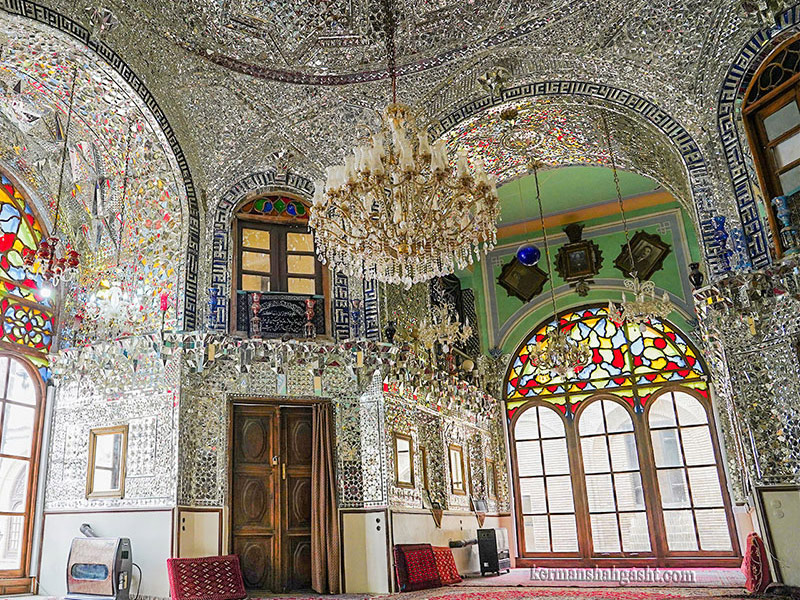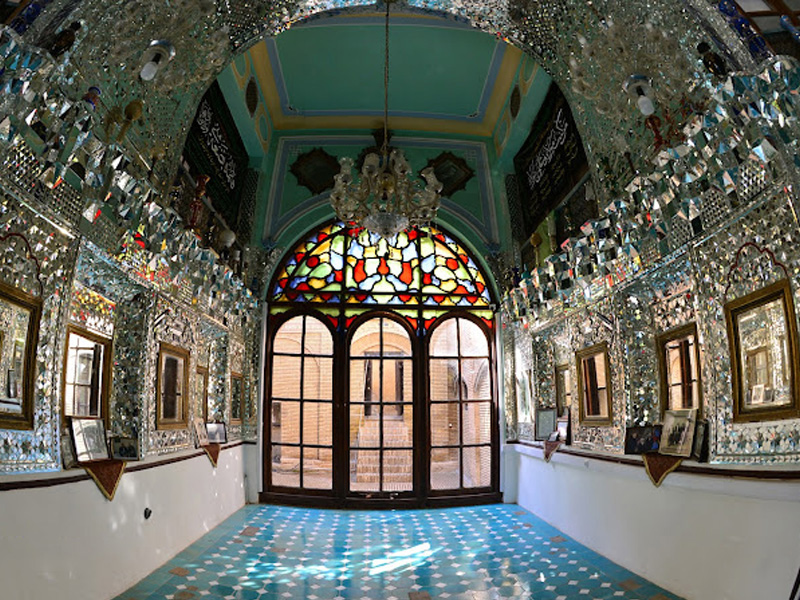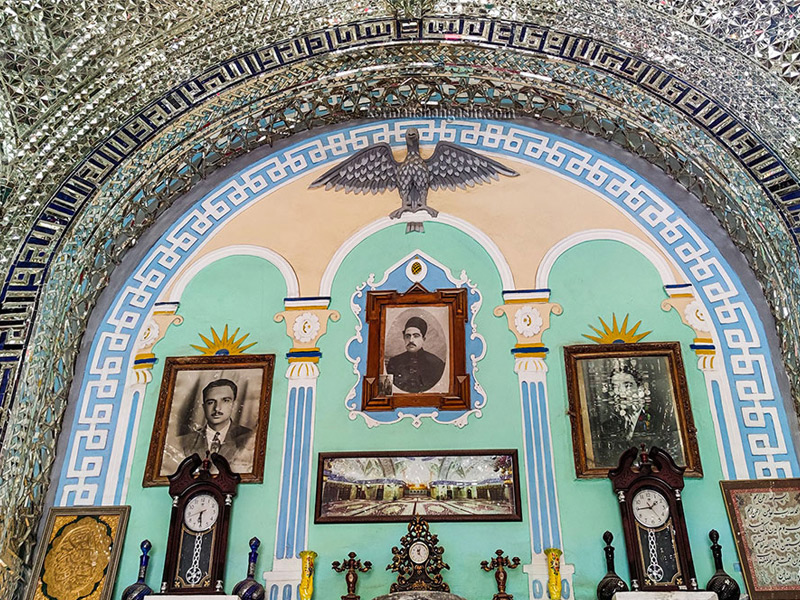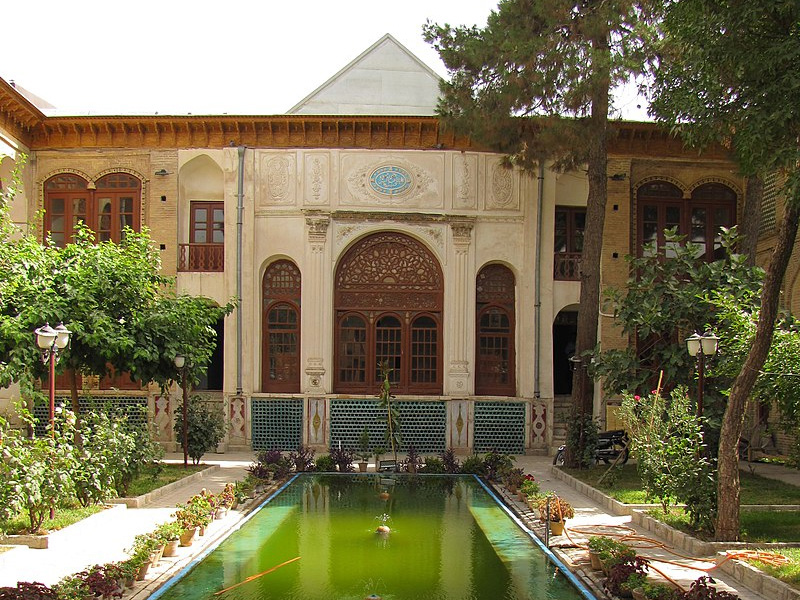Biglar Beigi Tekyeh is one of the historical and beautiful places in Kermanshah, Iran. Its history dates back to the Qajar period, and it was built by a person named Abdullah Khan, also known as Biglar Beigi. This historical and beautiful site was registered as No. 1797 in the list of national monuments of Iran on December 10, 1996. It is not only remarkable in terms of architecture but also has beautiful mirror and plaster decorations that add to its attractiveness. The first parietal museum in the Middle East, called the Zagros Parietal Museum, as well as the Calligraphy Museum, is located in Tekyeh Biglar Beigi, and by visiting this historical site, you have the opportunity to visit these two fascinating museums as well. This place is also known as Farashbashi Mansion.
Book Iran Air flights from London to Tehran and Tehran to London with Eligasht UK:
How can we get to Biglar Beigi Tekyeh Historical Site after arriving in Kermanshah?
Address: Kermanshah Province, Kermanshah City, Modarres Street, across from Jameh Mosque.
Biglar Beigi Tekyeh is located in the historical neighborhood of Feizabad on Modarres Street in Kermanshah, facing the Jameh Mosque.
Introduction to Biglar Beigi Tekyeh Historical Site in Kermanshah
Biglar Beigi Tekyeh Historical Site, located in parts of Kermanshah’s historical fabric, dates back to the Qajar period and showcases a combination of architecture prevalent during the Zand and Qajar eras for visitors to see. In addition to its historical value to Iran, the building features mesmerizing mirrors and plaster decorations that can be highly appealing to any visitor. During your visit to this site, you will come across numerous framed photographs of the founders of the site and famous individuals of the city.
The presence of the renowned Parietal Zagros Museum and the Calligraphy Museum in this place has added significance to this location and made visiting Biglar Beigi Tekyeh a must during a trip to Kermanshah. In the past, this place had an area of over 4,000 square meters and ample space on both sides of the entrance. The left section of it was used to accommodate foreign guests, while the spaces on the right were designated for livestock keeping. Currently, due to the allocation of these sections, this place has an area of approximately 2,000 square meters.
What do we know about the history of Tekyeh Biglar Beigi?
The construction of this beautiful historical site in Kermanshah city began in 1309 AH (Islamic calendar) by a person named Khadem al-Hussein Abdullah Khan Farashbashi, who was a prominent and influential figure in Kermanshah during the Qajar era. The construction of this site was completed by architects of that era after six years, in 1315 AH. Its decorations, including plaster and mirror work, were fully completed in 1326 AH and have been utilized since then.
In the past, Biglar Beigi Tekyeh not only served as a permanent venue for religious ceremonies but also as the residence of Abdullah Khan and his brothers and sons. On December 10, 1996, this place was registered as No. 1797 in the list of national monuments of Iran, and after the purchase of the property in 2001, restoration works were carried out in 2002 and 2003. In 2004, the Calligraphy Museum was established on this beautiful historical site, and in 2008, the highly renowned Zagros Parietal Museum started its activities on the southern side.

Different sections observed in Tekyeh Biglar Beigi
Entrance doors
Tekyeh Biglar Beigi, a beautiful historical structure from the Qajar period, has three entrance doors.
The main entrance door is located in the southeast of the place. The entrance door of this beautiful and historical Tekyeh showcases its prominent stucco and plaster decorations. Additionally, on both sides of the entrance door, two rows of arches catch the eye, with the lower row adorned with beautiful stucco and plaster decorations. The decorations inside the upper row of arches depict figures from the Qajar period.
The Octagonal Space
After the entrance door, there is a space called “Octagonal” in Tekyeh Biglar Beigi. The walls of this space feature noticeable arches, and its ceiling is decorated with brick patterns. On the northern side of the Octagonal space, there is a wooden door that provides access to the houses associated with Tekyeh Biglar Beigi.
The Dalan Space
After the Octagonal space, there is a relatively long space called “Dalan” that connects to the main courtyard of this place and is adorned with sanctuary decorations. On the southern side of the Dalan space, you will see two wooden gateway doors that provide access to the houses in the southern part of Tekyeh Biglar Beigi. On the northern side of the Dalan space, another entrance leads to a dead-end alley. This entrance can be used to access the residential areas on the northern side. The third entrance is located in the southwest.
The Courtyard
In Tekyeh Biglar Beigi, there is a relatively spacious courtyard with a large pool, which is about 2.5 meters lower than the street level. This spacious courtyard hosts a large number of people during the month of Muharram. The chains that remain from the past in the western Ivan indicate that in winter, they used to welcome the mourners by setting up tents in the courtyard.
In addition to this, in the northeastern corner of the large courtyard, there is a kitchen that was used during the days of Muharram to prepare food for the people who came to Tekyeh Biglar Beigi. The courtyard is paved with stone slabs, and in some parts, you can see stone plaques with geometric and floral designs. The courtyard is surrounded by various spaces, with the northeastern and southern parts used for residential purposes, and there is a dome chamber in the western section. The eastern part of the courtyard also has two-story spaces.

The Southern Section of the Courtyard
The southern section of the courtyard consists of four spaces, three of which have lattice windows. Stone stairs inside the courtyard of this place are used to access these spaces. This section of Biglar Beigi Tekyeh is about one meter higher than the courtyard level. The northern part of the courtyard is two-story. There is also a basement in this section, which can be accessed through the stairs inside the courtyard.
The basement of Biglar Beigi Tekyeh called “Howz-Khane,” serves as a special resting place for summer and has several rooms. The basement windows are in the form of lattice windows, which serve as wind catchers and have the same functionality as the basement. The ceiling of Howz-Khane and the summer resting place are covered with wooden beams and planks, and the rooms surrounding the brick arches are adorned with plaster decorations. Between the Howz-Khane and the summer resting place, two beautiful wooden columns with stucco work can be seen, with the columns’ stems in polygonal shapes and the capitals in the form of wooden capitals.
The arrangement of the rooms in Tekyeh Biglar Beigi
Biglar Beigi Tekyeh has 24 rooms. Access to these rooms, located on the first floor, is possible through the staircases inside the courtyard. The floor of the rooms is one meter higher than the courtyard level. In each of these rooms, there are 16 two-story niches built to store and protect personal belongings.
The rooms on the second floor, with a height of 1.5 meters, were used as storage spaces. To access the second floor, one must use the staircase located in the southeast room.
Shah-Neshin
The Shah-Neshin is located in the northern part of the first floor of Biglar Beigi Tekyeh and is surrounded by various spaces. In the Shah-Neshin, you can see beautiful wooden arches that depict self-portraits made of plaster on both sides. The stems of these self-portrait arches are decorated with spoon motifs, and the capitals are Byzantine-style capitals with floral and plant motifs.
The interior space of the Shah-Neshin is decorated with plaster designs, geometric patterns, floral motifs, frames, and plaster columns, creating great appeal for any viewer. In the upper section of the Shah-Neshin, there is a plaster frame with the inscription “Ya Aba Abdullah Al-Hussein and the year 1262.” It seems that the date mentioned in this inscription represents the completion date of the plasterwork in Tekyeh. The Shah-Neshin room was likely used for receiving and meeting individuals by the Biglar Beigi, and the surrounding rooms and the upper floor served as resting spaces.
The Beautiful and Historical Dome Space in Tekyeh Biglar Beigi
The dome space in Biglar Beigi Tekyeh is considered its most important section. It is located in the western part of the Tekyeh and has a relatively large courtyard connected by a stone staircase. Two relatively tall wooden columns and two façade columns with plaster coverings are prominent in this courtyard. Their capitals are similar to Byzantine capitals adorned with floral and plant motifs. The ceiling of the courtyard is decorated with wood carvings. There is a beautiful large wooden archway in the courtyard that connects it to the main space of the Hosseiniyeh (religious hall).
The Hosseiniyeh space in Tekyeh is a two-story section with six rooms on each floor. The ceiling of the Hosseiniyeh is covered with a dome, which features tile work on the exterior and beautiful mirror work on the interior. Each of the eaves of the Hosseiniyeh space has a crescent-shaped arched window, surrounded by mirror work inscriptions of the sacred phrases “There is no god but Allah, and Muhammad is the Messenger of Allah” and “Ali is the Vicegerent of Allah.” The mirror work in this section was done by Master Mohammad Ali Tehrani in 1326 AH.
Among the other decorations in the Hosseiniyeh that attract visitors’ attention are the plaster façade columns, geometric patterns, plant motifs, and candle-lit lanterns. On the southern side of this space, there is a beautiful archway with colored glass, which connects the Hosseiniyeh to a smaller courtyard. Through this courtyard, one can enter the Biglar Beigi Bathhouse complex. The southern side of the Hosseiniyeh space was used for women’s presence during the mourning ceremonies and for storing ceremonial items. Unfortunately, the large Shah-Neshin room on the western side of the Hosseiniyeh has been demolished due to the widening of Madrese Street in the past years.
the Calligraphy and Manuscript Museum
The Calligraphy and Manuscript Museum of Kermanshah’s historical city was established in 2004 in Tekyeh Biglar Beigi. It includes historical documents, manuscripts, and handwritten copies. There are also documents related to the Biglar Beigi family in this museum. Approximately 300 valuable historical documents and manuscripts are preserved in this calligraphy and manuscript museum. Some of these manuscripts have been translated into modern Persian due to their antiquity and are displayed alongside other documents for visitors to see.

Zagros Petroglyph Museum: Another Museum in Tekyeh Biglar Beigi
The Zagros Petroglyph Museum, located in Tekyeh Biglar Beigi, is a specialized museum dedicated to prehistoric activities. It was founded by Fereydoun Biglari and Alireza Moradi Bistouni in 2007. The existence of petroglyph areas in the Zagros region and the favorable conditions of this area for hunting are the main reasons for establishing this museum in this location. The Zagros Petroglyph Museum houses the oldest discovered evidence of human habitation in Iran, such as stone tools and carved animal figurines. The oldest petroglyph preserved in this museum is a stone tool dating back nearly one million years from the Khurasan River discovery period.
The Zagros Petroglyph Museum is considered the first museum of its kind in the Middle East. It is highly attractive to tourists due to the presence of simulated replicas of Neanderthal humans, the distribution of documentaries on the petroglyph period in Iran and the world, as well as a map of the locations of petroglyph caves in Iran, which are displayed in this museum.
Related post
Anahita Temple, Kermanshah Province
Bisotun Historical Site, a UNESCO World Heritage Site
Final words
For visitors and tourists interested in immersing themselves in the religious and cultural heritage of Kermanshah, a visit to Biglar Beigi Tekyeh is highly recommended. The complex is open to the public, allowing visitors to witness the grandeur of its architecture and experience the spiritual atmosphere.
FAQ
1- What is Tekyeh Biglar Beigi?
It is a historical complex located in Kermanshah, Iran. It consists of a religious hall (Hosseiniyeh), a dome space, a bathhouse, and a calligraphy and manuscript museum. It holds great cultural and architectural significance in the region.
2- What is the historical significance of Tekyeh Biglar Beigi?
This place has a rich history dating back several centuries. It served as a gathering place for religious ceremonies, especially during the mourning rituals of Muharram. It also played a role in preserving and promoting Persian literature and calligraphy.
3- What are the notable architectural features of this place?
Biglar Beigi Tekyeh showcases impressive architectural elements. The dome space features wooden and plaster columns, intricate wood carvings, and beautiful archways. The religious hall (Hosseiniyeh) has a decorated ceiling, mirrored inscriptions, and captivating plaster façade columns.
4- Is there a museum in Tekyeh Biglar Beigi?
Yes, there is a calligraphy and manuscript museum within the complex. It was established in 2004 and houses a collection of historical documents, manuscripts, and handwritten copies. The museum provides insights into the region’s rich cultural heritage.

